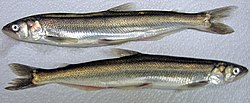Candlefish
| Eulachon | |
|---|---|
 |
|
| Scientific classification | |
| Kingdom: | Animalia |
| Phylum: | Chordata |
| Class: | Actinopterygii |
| Order: | Osmeriformes |
| Family: | Osmeridae |
| Genus: |
Thaleichthys Girard, 1858 |
| Species: | T. pacificus |
| Binomial name | |
|
Thaleichthys pacificus (J. Richardson, 1836) |
|
The eulachon (Thaleichthys pacificus), also oolichan, hooligan, ooligan, or candlefish, is a small anadromous ocean fish, a smelt found along the Pacific coast of North America from northern California to Alaska.
The common names of this fish have a somewhat confusing relationship. The name "candlefish" derives from it being so fat during spawning, with up to 15% of total body weight in fat, that if caught, dried, and strung on a wick, it can be burned as a candle. This is the name most often used by early explorers. The name eulachon (occasionally seen as oolichan, oulachon, and uthlecan) is from the Chinookan language and the Chinook jargon based on that language. There is a theory that the term "hooligan" was influenced by "eulachon", rather than simply taken from the Irish surname.
The unrelated sablefish Anoplopoma fimbria is also called "candlefish" in the United Kingdom.
Eulachon are distinguished by the large canine teeth on the vomer bone and 18 to 23 rays in the anal fin. Like salmon and trout they have an adipose fin; it is sickle-shaped. The paired fins are longer in males than in females. All fins have well-developed breeding tubercles (raised tissue "bumps") in ripe males, but these are poorly developed or absent in females. Adult coloration is brown to blue on the back and top of the head, lighter to silvery white on the sides, and white on the ventral surface; speckling is fine, sparse, and restricted to the back. Adults can reach maximum lengths of 30 cm (0.98 ft) but most adults are between 15 and 20 cm (6 and 8 in) They feed on plankton but only while at sea.
Eulachon feed primarily on plankton as well as fish eggs, insect larvae, and small crustaceans. It forms an important part of the diet of many ocean and shore predators, and serves as a prominent food source for people living near its spawning streams.
...
Wikipedia
